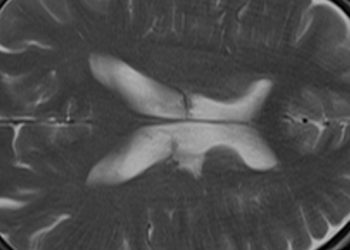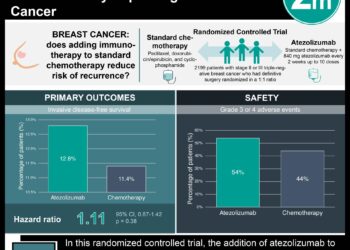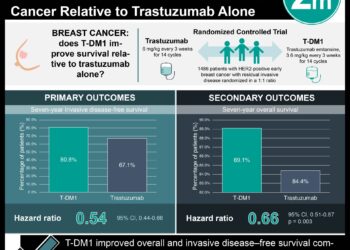Breast MRI most sensitive screening modality in high-risk patients [Classics Series]
This study summary is an excerpt from the book 2 Minute Medicine’s The Classics in Medicine: Summaries of the Landmark Trials
1. Among patients with a familial or genetic predisposition to the development of breast cancer, magnetic resonance imaging (MRI) of the breast was significantly more sensitive than either clinical exam or mammography for the detection of invasive breast cancer.
2. Invasive breast cancers detected by MRI were more frequently less than one centimeter in diameter and displayed a lower incidence of axillary nodal metastases or micrometastases than those detected by mammography or clinical breast exam.
Original Date of Publication: July 2004
Study Rundown: Breast cancer screening for women aged 50 to 70 has been shown to significantly reduce cancer-related mortality. However, for women with a strong family history of early breast cancer or known germline oncogenic mutations such as the BRCA1 or BRCA2 mutations, screening at an earlier age may be warranted due to their high lifetime cancer risk. Screening of the general population at younger ages has been of unclear value due to increased breast density among premenopausal women potentially reducing the sensitivity of mammography. Among those with genetic predispositions to breast cancer, mammography has been further limited, demonstrating a low sensitivity for cancer detection due in part to rapid tumor growth and an increased incidence of atypical historadiological characteristics of the tumors in these women. Contrast-enhanced breast MRI had been suggested as an alternative screening modality for high-risk women given its high sensitivity and the relative indifference of the modality to breast density. In the referenced article, yearly mammography and serial clinical breast examinations were prospectively compared to yearly screening breast MRI in younger women with an established predisposition to breast cancer. In nearly 3 years of screening high-risk women with a mean age of 40 years, contrast-enhanced breast MRI was by far the most sensitive modality at 79.5%, performing significantly better than either mammography or clinical breast exam at 33.3% and 17.9%, respectively. However, the specificity and positive predictive value of MRI was the lowest of the three methods at 89.8% and 7.1%, as compared to mammography at 95.0% and 8.0%, respectively. Notably, tumors detected by breast MRI were significantly more likely to be of lower stage, with more tumors found at sizes less than 10 mm in diameter, and fewer tumors with micrometastases or axillary nodal metastases, suggesting earlier detection in the natural course of the disease. No differences in disease-free or overall survival could be determined as no mortalities were recorded during the course of the study. These findings demonstrated that MRI had significantly better overall discriminating capacity than either mammography or clinical breast exam in screening women at high-risk for breast cancer.
Click to read the study in NEJM
In-Depth [prospective cohort]: This prospective trial enrolled 1909 women (mean age 40 years; range 19-72 years, 75% premenopausal) at multiple centers across Europe who were known to be at high risk for breast cancer (greater than 15% lifetime risk) due either to a strong family history of early breast cancer or known genetic mutation. Women were excluded from the study if they had symptoms suggestive of current breast cancer or a personal history of breast cancer. All subjects were screened by twice yearly clinical breast exam and yearly mammography and contrast-enhanced breast MRI over a median follow-up period of 2.9 years (mean 2.7, range 0.1-3.9 years). Results from each modality were blinded such that no examination could influence another. Radiologic studies were scored on the BI-RADS system, with the threshold for positivity set to category 3 (“probably benign or uncertain result”) for both statistical analysis and further investigation by ultrasonography, fine-needle aspiration or biopsy as necessary. Results of these further investigations were used to diagnose a tumor as benign or malignant, and formed the basis for subsequent determinations of specificity and positive predictive value for each screening modality. The overall sensitivity of MRI for the detection of invasive breast cancers (excluding ductal carcinoma in situ) among high-risk women was 79.5% using BI-RADS 3 or higher as the cutoff for positivity, as compared to 17.9% for clinical breast exam and 33.3% for mammography. The specificity of clinical examination was the highest at 98.1%, while mammography and breast MRI were 95.0% and 89.8%, respectively. The positive predictive value of MRI was 7.1% as compared to 9.6% for clinical exam and 8.0% for mammography. Based on the area under the receiver operator curves for both MRI and mammography, MRI showed a significantly better discriminating capacity than mammography (Difference in AUC 0.141, 95%CI 0.020-0.262; p <0.05). Tumors detected by MRI were generally of a lower stage than those detected by alternative methods, with 43.2% found at a diameter of less than 10 mm, versus only 12.5% and 14.0% in each respective average risk control group (p <0.001 and p = 0.04). Additionally, the incidence of either positive axillary lymph node metastases or micrometastases was 21.4% as compared to 52.4% and 56.4% in each control group (p <0.001 and p = 0.001, respectively.) During the median 2.9 years of follow up, none of the patients with breast cancer died, therefore no difference of disease-free or overall survival could be assessed.
Kriege M, Brekelmans CT, Boetes C, Besnard PE, Zonderland HM, Obdeijn IM, et al. Efficacy of MRI and Mammography for Breast-Cancer Screening in Women with a Familial or Genetic Predisposition. The New England Journal of Medicine. 2004 Jul 29;351(5):427–37.
©2022 2 Minute Medicine, Inc. All rights reserved. No works may be reproduced without expressed written consent from 2 Minute Medicine, Inc. Inquire about licensing here. No article should be construed as medical advice and is not intended as such by the authors or by 2 Minute Medicine, Inc.







![The ABCD2 score: Risk of stroke after Transient Ischemic Attack (TIA) [Classics Series]](https://www.2minutemedicine.com/wp-content/uploads/2013/05/web-cover-classics-with-logo-medicine-BW-small-jpg-75x75.jpg)